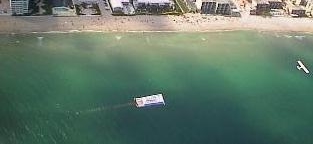 Sunday, February 28 - 920 feet over Pompano Beach, Florida -
Nobody has ever had to ask Dan Thomas why he likes his job - it's pretty obvious. As a Goodyear blimp pilot, he gets to fly one of the world's most beautiful, most well known aircraft, and well, he gets to fly, period, which is what all humans without wings would like to do.
Sunday, February 28 - 920 feet over Pompano Beach, Florida -
Nobody has ever had to ask Dan Thomas why he likes his job - it's pretty obvious. As a Goodyear blimp pilot, he gets to fly one of the world's most beautiful, most well known aircraft, and well, he gets to fly, period, which is what all humans without wings would like to do.
Thomas is one of four pilots of the Stars and Stripes, a Goodyear blimp based only a short flight from Miami, in Pompano Beach, Florida. Sometimes he flies people over the beautiful beaches here, sometimes he flies a camera over sporting and other events, and sometimes he flies cross-country, but all he does is fly, and that is a beautiful life.
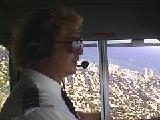
When Goodyear first flew a promotional balloon in 1925, one of the country's greatest marketing devices was born. No other organization has accomplished such a long-standing promotional coup as has Goodyear with its blimp. It is a bold statement emblazoned across America's skies, and brought into our living rooms through major sporting events which Goodyear helps televise. The Goodyear blimp is the only blimp, and any other blimp is just a blimp with a company's logo. The term "Goodyear blimp" has become so common, that it has become its own misnomer. There are actually three Goodyear blimps; one in Los Angeles and one in Akron, as well as the Stars and Stripes, but each one is still referred to as "the Goodyear blimp" floating it above physical status and into a mythical class of legends.

At the Controls
Thomas has many digital readings from which he can monitor the performance of his two 240 hp engines; Oil temperature, manifold pressure and RPMs. The readouts for each engine sit side- by- side and show nearly identical readings. "Our ground crew is excellent," he says. "They keep these engines running in top shape."
He also has color weather radar, GPS, two altimeters (one atmospheric and one radar) and a "Moving Argus Map" which gives him a constant display of air traffic and landmarks all around us.
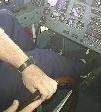 To monitor the "envelope" above us, one gauge tells us the pressure in the envelope and two others tell us the pressure in the balonets, which are filled with air, and are expanded or contracted to control our lift. Thomas uses foot pedals to steer the rudder left and right, which soon turns us left and right. A hardwood wheel, about the size of the wheel on your dad's 1950's Plymouth, sits between Thomas and I and he uses it to control the craft's elevator, steering us up and down. Cables in the top of the gondola control the pressure in the balonets.
To monitor the "envelope" above us, one gauge tells us the pressure in the envelope and two others tell us the pressure in the balonets, which are filled with air, and are expanded or contracted to control our lift. Thomas uses foot pedals to steer the rudder left and right, which soon turns us left and right. A hardwood wheel, about the size of the wheel on your dad's 1950's Plymouth, sits between Thomas and I and he uses it to control the craft's elevator, steering us up and down. Cables in the top of the gondola control the pressure in the balonets.
|
Blimps fly because they are filled with helium, a very thin gas that is lighter than air. Most Goodyear blimps are named after America's Cup sailboat race winners, because they are considered "giant sailing ships of the skies." The tie to Goodyear was that blimps originally had a thin, rubberized canvas skin, but after making over 300 of these ships, many for the military, Goodyear no longer makes them. Early ships had rigid, metal frames and were much larger. The Stars and Stripes is 192 feet long and weighs, at most, just under 13,000 pounds, compared to the blimps of the 1930's, which were more than three times as long and thirty times as heavy.
Dan Thomas grew up in south Florida, and he often watched the Goodyear blimp fly over his house, but never thought he could ever pilot one of them. When he was eighteen, he joined the ranks of this elite crew and spent over a decade on the ground. He worked as a mechanic, an electrical technician, and even in the offices here for years before he decided he would take the controls. He earned his FAA commercial pilot's license, with an instruments, twin engine rating, and then trained for over 200 hours until he was allowed to captain, as he has done for eight years, logging over 2,000 hours in this lighter-than-air craft. As we sail along the beautiful coastline, pilot Thomas is relaxed, with his right hand on the controls and his left arm out the open window, something you just don't see in an airplane.

Thomas flies an airplane occasionally, and he appreciates the difference. "You definitely have to pay attention to what vehicle you're in," he says, after we take off and head for the beach. "Because they're not the same - that's for sure." We are sailing, floating among the clouds, in control only so much as our engines can push this huge ship between the gusts and currents. Thomas says that a blimp is "like a cross between a twin engine airplane and a large boat." Every move he makes to control the ship is delayed by a few seconds. He kicks the right rudder, and gently, we turn to the right. He spins the wheel forward and we soon nose into a slow-motion dive. The attitude of the ship doesn't dictate its flight path, so much as the wind around it does, and we are sometimes actually flying sideways. "I don't go by where it's pointing," he says. "I go by where it's going."
This blimp spends eight months in south Florida, then the entire crew goes on tour with it for the summer, riding in a tour bus, a tractor-trailer truck and a passenger van, they cross the country, sleeping in hotels, landing in fields and airports, hovering over sporting and other large events, meeting the public and flying. The ship is never deflated and trucked anywhere - it is always flown, and flown in an unusual way.
"You fly this by the seat of your pants," says Thomas. "You are constantly using judgment - the feel of the ship is something you have, you just can't get it from instruments." There are less than one hundred blimp pilots in the country and you could bet that most of them are in pretty good shape. Flying over the beach, Thomas constantly wrestles with the controls. "It doesn't leave you alone for even one second," he says, squirming in his seat, pushing the rudder pedals, and spinning the elevator wheel. Sometimes, he works harder than the quarterback which his Gyrocam 360 television camera is trained upon.
While in Florida, the pilots fly Goodyear employees and their guests on prearranged goodwill trips, where the pilots only fly for an hour at a time, alternating between flights. On a cross country trip, two pilots may spend an entire day on a ship, flying only thirty to fifty miles each hour, and during an event, it can seem even more monotonous. "Sometimes, it's 5-6 hours of going around in a circle," Thomas says, "in everything from great weather conditions to terrible weather conditions." Thomas enjoys flying for car races, because he can follow the action nicely from his vantage point. I did actually ask him why he enjoys his job, aside from the obvious reason. "You're pretty much your own boss up here," he tells me. "By the same token though, all the responsibility is on you."
 The entire blimp operation here appears to be a great place in which to work. Discussing the outfit with mechanics, pilots and office personnel, I found that many have worked here for decades, and, even though everybody has to drop what they're doing and run outside to the landing pad several hundred yards away and grab hold of a huge flying object and pull it to earth each hour, several days a week, they are happy with their work. "I have no complaints here in 18 years," says Thomas.
The entire blimp operation here appears to be a great place in which to work. Discussing the outfit with mechanics, pilots and office personnel, I found that many have worked here for decades, and, even though everybody has to drop what they're doing and run outside to the landing pad several hundred yards away and grab hold of a huge flying object and pull it to earth each hour, several days a week, they are happy with their work. "I have no complaints here in 18 years," says Thomas.
 A popular feature of the Goodyear blimps is their "Super Skytacular" displays. At 105 feet long, these may well be the world's largest reader boards. Each display is actually a matrix of 7,560 LED's mounted on printed circuit boards (the board on the left is about three inches tall, and they can be seen in the side photo) and can deliver near-photo quality images to the night sky.
A popular feature of the Goodyear blimps is their "Super Skytacular" displays. At 105 feet long, these may well be the world's largest reader boards. Each display is actually a matrix of 7,560 LED's mounted on printed circuit boards (the board on the left is about three inches tall, and they can be seen in the side photo) and can deliver near-photo quality images to the night sky.
When Hurricane Andrew hit Homestead, Florida, some fifty miles south of this base, the blimp was in Kentucky. With widespread damage that wiped out power and phone lines and affected millions of people, there was a major communications problem. To compound the mess, many victims did not speak English. So the crew brought the blimp home quickly and flew it over the disaster site, using its giant reader boards to display messages in English, Creole and Spanish; "Aqua Embotellada," read one message, telling people where they could find bottled water. Only about half of the messages flashed on this blimp are for Goodyear, with the others for public service.
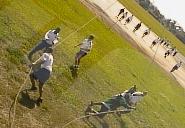 After about half an hour in the sky, it is time for us to return. We approach the base and I can see a dozen men walking toward the pad. "Every single landing is different," says Thomas. Indeed, ours is very different. The wind today is not only strong, but it is gusty and it shifts erratically. The ground crew runs out and a few men grab hold of the bow lines, trying to pull the 192 foot-long beast to the ground. Thomas has the engines revved and the elevator down hard and he's trying to keep this monster faced into the wind. But the wind shifts and pulls us away and up. The ground crew has the good sense to know when to let go of the lines - I know I saw one kid airborne for a moment - and we take off for a second approach.
After about half an hour in the sky, it is time for us to return. We approach the base and I can see a dozen men walking toward the pad. "Every single landing is different," says Thomas. Indeed, ours is very different. The wind today is not only strong, but it is gusty and it shifts erratically. The ground crew runs out and a few men grab hold of the bow lines, trying to pull the 192 foot-long beast to the ground. Thomas has the engines revved and the elevator down hard and he's trying to keep this monster faced into the wind. But the wind shifts and pulls us away and up. The ground crew has the good sense to know when to let go of the lines - I know I saw one kid airborne for a moment - and we take off for a second approach.
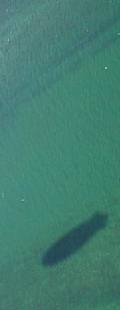 We circle the golf course again, and Thomas tacks into the strongest gusts, eyeing the 20-knot wind sock, which is pointing right at us. As we approach the ground, the winds get even more gusty and shifty and we are bounced around a bit. I'm worried about the ground crew scrambling around the ship, with the 78 inch propellers, which Thomas now has humming at about 2,700 RPM. Two men run to the gondola with heavy sandbags and load us down, then they jump on the rails. Thomas is fighting with the wind, as it tries to spin us around. A crewman opens the side door and our passengers climb out. I jump off the airship, and another pilot boards. He and Thomas trade off the controls and Thomas jumps out. We run clear of the Stars and Stripes and it takes off for another adventure.
We circle the golf course again, and Thomas tacks into the strongest gusts, eyeing the 20-knot wind sock, which is pointing right at us. As we approach the ground, the winds get even more gusty and shifty and we are bounced around a bit. I'm worried about the ground crew scrambling around the ship, with the 78 inch propellers, which Thomas now has humming at about 2,700 RPM. Two men run to the gondola with heavy sandbags and load us down, then they jump on the rails. Thomas is fighting with the wind, as it tries to spin us around. A crewman opens the side door and our passengers climb out. I jump off the airship, and another pilot boards. He and Thomas trade off the controls and Thomas jumps out. We run clear of the Stars and Stripes and it takes off for another adventure.
The secret to flying a blimp? "It takes patience," Captain Dan Thomas tells me afterward. "And it takes the right attitude about this kind of flying." Attitude is important, because it is obvious that you don't fly a blimp to get someplace, you fly a blimp to be someplace, and that place is usually a thousand feet up, with the world below you, and your beautiful life before you, and all your troubles vanished into thin air.
